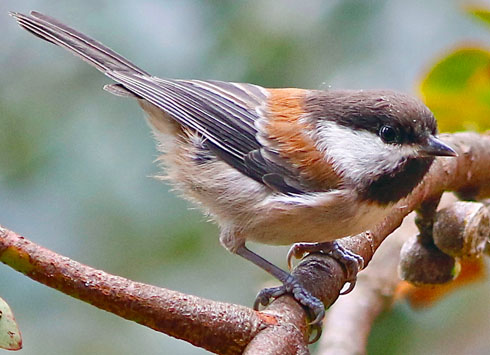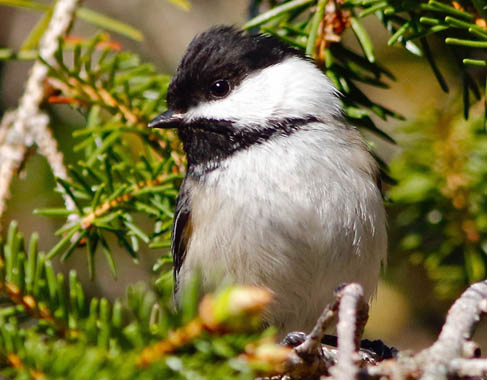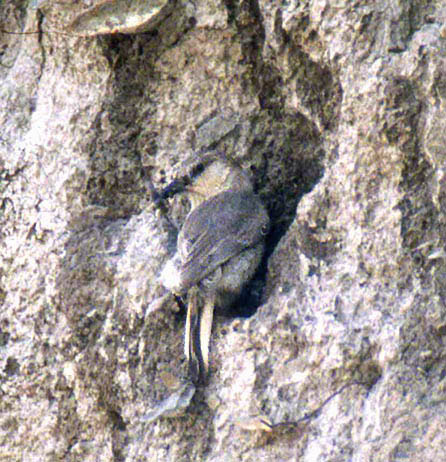
a web page by Don Roberson |
PARIDS Paridae |
||||||
|
||||||
The center of distribution for parids is in the Himalayan Range, where there are an abundance of tits in elevational ranges from the tropics to treeline. This lovely species (left) is Yellow-cheeked Tit, which ranges from eastern Nepal to southeast China, and in mountain ranges to northern Burma, Thailand, and Laos. This photo is from Bhutan, which most be in the center of parid diversity. We had 8 parids from the subtropics to tree-line, including Yellow-cheeked and 5 more in the gallery just below [not shown are photos of Coal Tit Pariparus ater and Fire-capped Tit Cephalopyrus flammiceps, also seen on the trip]. |
||||||
|
||||||
All the parids of Africa are either black-and-white, or patterned in black, gray, and white, or have rusty mixed in with these colors in a few species.
|
||||||
Now (in 2020), the most recent Clements/eBird checklist divides the old Great Tit into 3 species that mirror the "groups" in Harrap & Quinn — Great Tit, Cinereous Tit P. cinereus in the central and south Asia, and Japanese Tit P. minor in Japan, China, and southeast mainland Asia — but "Turkestan Tit" is now lumped into Cinereous Tit. Willow Tit Poecile montanus, a widespread species of Palearctic forest, has also undergone a confusing taxonomy. Harrap & Quinn (1995) split a couple of races in China, which had been initially considered to be subspecies of Willow Tit, as a species called "Songar Tit P. songarus" [photo from China, right]. Again, today, those races are merged back into Willow Tit. We have not yet seen "the last word" on these topics. |
||||||
|
||||||
In coastal California, where I live, two parids are common residents in our yard. All the New World tits are called chickadees, and ours is Chestnut-backed Chickadee (above left and in flight). All of North America's crested parids are called titmouses; ours is Oak Titmouse (above right). I rather like all the tits for their curiosity and cleverness, but I particularly appreciate Chestnut-backed Chickadee. It is the focal species for foraging flocks of small songbirds, and a key species to locate when searching for vagrant warblers or vireos in the fall. A good chunk of "eastern" vagrants that I've seen in Monterey County have been with these chickadee flocks. The same holds true for Christmas counts when the prizes are not necessarily vagrants, but scarce wintering western species, like Black-throated Gray Warbler. Again, one listens for the chickadees to find the flocks. As I often say on Christmas Bird Counts: "where there's chickadees, there's hope!" When the local Big Sur Ornithology Lab (BSOL) existed, they did a study of Chestnut-backed Chickadees. They caught and color-banded good numbers along the Big Sur River and followed them for several years, gaining significant insights into behaviors, survivorship, ecology, and movements. Both the chickadee and the titmouse find holes in trees, often created by woodpeckers, to use for their nests — one chickadee shown above is flying away from such a hole-nest after delivering food to the chicks inside. Both our chickadee and our titmouse readily used nest boxes with the right-size hole. One summer they used a nest box that had been a Christmas gift, stuck to the fence right above our hot tub. After the young had fledged we opened the box and found this perfect 3-inch pad, composed mostly of strips of redwood back, that had cushioned the eggs. It was immaculately clean — apparently tits are excellent house-cleaners. Over the decades a pair of chickadees, or a pair of titmouses, have used it most years. Among the coniferous evergreens of the western mountains of North America the resident parid is Mountain Chickadee (below left). Most species of chickadee give a distinctive, variably nasal "chick-a-dee-dee-dee" call that is often heard in temperate woodlands. Some incorporate these notes within their territorial song while others, including Mountain Chickadee, have another and entirely different song — a mellow, whistled series recalling Zonotrichia sparrows. Locally, I should mention that my rediscovery of nesting Mountain Chickadees near Cone Peak, Monterey County, in 1991 — after their 30 year absence — was my personal highlight of our Breeding Bird Atlas project (Roberson & Tenney 1993). Now, 20 years later, that population has disappeared again, quite possibly due to extensive wildfires that swept over the habitat in the last decade. In eastern deciduous forests of North America, two very similar chickadees divide the habitat between a southern species (Carolina Chickadee Poecile carolinensis) and a northern one (Black-capped Chickadee; below right). Black-capped Chickadee also widespread in mixed forests across Canada, and was once considered conspecific with Willow Tit of Eurasia, as they are very similar in appearance. There is narrow hybrid zone between Black-capped and Carolina chickadees that is shifting northward in response to increasing winter temperatures but is not increasing in width. This pattern indicates strong selection against chickadees with admixed genomes. A recent study found that hybrids had a higher basal metabolic rates than either parental species and suffer spatial memory and problem-solving deficits, permitting the parental species to continue to be separate biological species; Wagner et al. 2020). |
||||||
|
||||||
| There had been some disagreement in the past about family status for the Paridae. Most authorities had classified parids as a distinctive family, but Sibley & Ahlquist (1990), based on preliminary DNA-DNA evidence, considered them a subfamily of a larger group that includes treecreepers and penduline tits. It is unfortunate that the recent family text (Harrap & Quinn 1995) followed this approach a bit too quickly. Instead, newer genetic work (e.g., Gill, Slikas & Sheldon 2005) shows that the Paridae are a unique lineage that arose in Asia. The ancestors of American titmice colonized the New World about 4 million years ago, and the ancestors of American chickadees followed about 3.5 million years ago. | ||||||
|
||||||
The "newest" member of the Paridae is "Hume's Groundpecker" — a unique and puzzling passerine of the Tibetan and Qinghai Plateau of east-central Asia— recently re-named Ground Tit (above and below). Until the turn of the 21st century, it was considered to be a member of the crow & jay family Corvidae — the world's smallest jay — although doubts were expressed as early as the 1970s (Borecky 1978). It is a small, plain-colored bird: barely 20 cm (7.8 inches) long, a little bigger and heavier (but shorter-tailed) than a wagtail and just a little smaller than a Sage Thrasher. It is very much a terrestrial species, living in grassy and stony habitats high on the Tibetan plateau, and moving about on long bounding hops, frequently flicking its tail when it stopped and flying only rarely. They dig actively for insects with their strong bill in turf, soil, and yak dung (Londei 2002, James et al. 2003). This little-known species was described by Hume in 1871 with the generic name Podoces (which roughly translates "puzzling chough-thrush;" Londei 2002), along with another new species, Mongolian Ground-Jay Podoces hendersoni. For years It was known by such names as "Hume's Ground-Jay" and "Tibetan Ground-Jay" (e.g., Sibley & Monroe 1990). |
||||||
 |
||||||
Photos: The Yellow-cheeked Tit Machlolophus spilonotus was at Zhemgang Road, Bhutan, on 29 March 2019. The Gray-crested Tit Lophophanes dichrous was at Chendebji, Bhutan, on 29 Mar 2019. The Rufous-vented Tit Periparus rubidiventris was at Cheela La pass, Bhutan, on 3 Apr 2019. Green-backed Tit Parus monticolus was at Trashingong, Bhutan, on 20 Mar 2019. The Sultan Tit Melanochlora sultanea was at Morong, Bhutan, on 18 Mar 2019. The Yellow-browed Tit Sylviparus modestus was along the Jakar-Trongsa Road, Bhutan, on 26 Mar 2019. The Carp's Tit Melaniparus carpi was in Etosha NP, Namibia, in July 2005. A member of the "Songar" group of Willow Tit Poecile montanus [songarus] was photographed at Wulingshan, Hebei, China, on 9 June 2004. The Chestnut-backed Chickadee Poecile rufescsens was in my backyard in Pacific Grove, Monterey Co., California, on 2 Sep 219. and the juv Oak Titmouse Baeolophus inornatus was there on 22 June 2008; the nest and flying Chestnut-backed Chickadee were along Conejo Creek, Monterey Co., on 25 Apr 2020. The Mountain Chickadee Poecile gambeli was at Indian Creek Reservoir, Alpine Co., California, on 26 Oct 2019. The Black-capped Chickadee Poecile atricapillus was at Saratoga National Historic Park on 16 May 2019. All the photos of Ground Tit Pseudopodoces humilis were digiscoped in Qinghai Province, China, in June 2004. The top shot was in the Caka Valley, the bottom near Qinghai Lake, and the nest on Rubber Mountain Pass. All photos © Don Roberson; all rights reserved. Family book:
Literature cited:
|
||||||
 The Paridae is a family of active small birds — called tits, titmouses, or chickadees — that are primarily resident in forest and woodlands around the globe, excepting the Neotropics and Australasia. All parids are agile, foraging by clinging to limbs, often upside down, and full of character. The British name — tits — has roots reaching back to the 14th century, apparently of onomatopoeic origin, meaning "small bird" (Harrap & Quinn 1995). Except for variations in pattern and habitat, birdwatchers find it easy to identify "tits" as members of the Paridae. Indeed, at one time, nearly all of the family was assigned to a single genus: Parus. (e.g, Harrap & Quinn 1995). Now, after various molecular studies, the Paridae are split into 13 genera (e.g., Gosler & Clement 2007).
The Paridae is a family of active small birds — called tits, titmouses, or chickadees — that are primarily resident in forest and woodlands around the globe, excepting the Neotropics and Australasia. All parids are agile, foraging by clinging to limbs, often upside down, and full of character. The British name — tits — has roots reaching back to the 14th century, apparently of onomatopoeic origin, meaning "small bird" (Harrap & Quinn 1995). Except for variations in pattern and habitat, birdwatchers find it easy to identify "tits" as members of the Paridae. Indeed, at one time, nearly all of the family was assigned to a single genus: Parus. (e.g, Harrap & Quinn 1995). Now, after various molecular studies, the Paridae are split into 13 genera (e.g., Gosler & Clement 2007).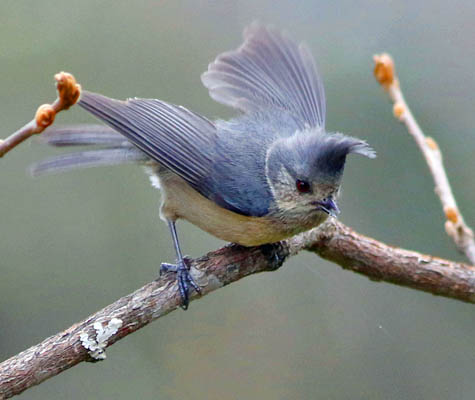
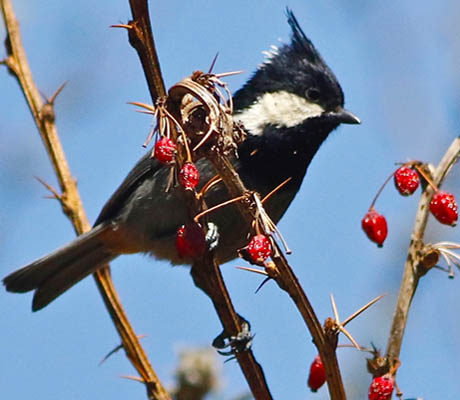
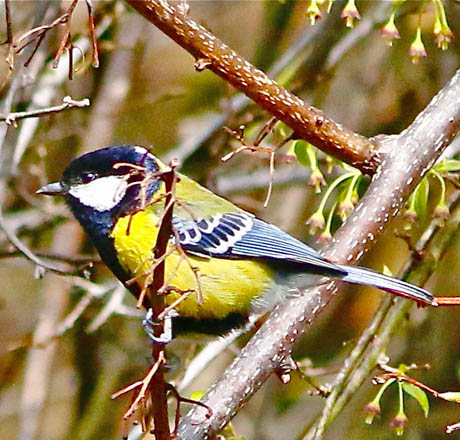


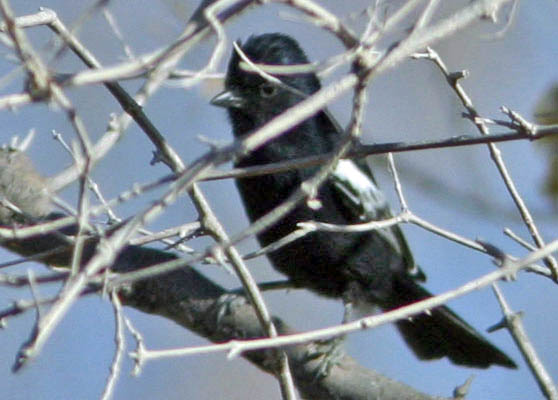 The Paridae have an interesting distribution for a more-or-less global family. They occur throughout Eurasia — east to Japan, the Philippines, and to Java and the Lesser Sundas — and in Africa, but only North America in the New World. They are entirely absent from South America (indeed, they don't occur south of Mexico) and none cross Wallace's Line into Australasia. There are some desert species and subtropical species, but most parids are birds of temperate latitudes. The only parid that is bird of tropical forests is Dusky Tit Melaniparus funereus for west and central Africa. There are 16 parids in Africa — if we include Great Tit in northernmost Africa — but these are birds of savanna, thornscrub, and light woodlands, such as Carp's Tit (left) of Namibia and Angola, and black-and-white tit of thornscrub.
The Paridae have an interesting distribution for a more-or-less global family. They occur throughout Eurasia — east to Japan, the Philippines, and to Java and the Lesser Sundas — and in Africa, but only North America in the New World. They are entirely absent from South America (indeed, they don't occur south of Mexico) and none cross Wallace's Line into Australasia. There are some desert species and subtropical species, but most parids are birds of temperate latitudes. The only parid that is bird of tropical forests is Dusky Tit Melaniparus funereus for west and central Africa. There are 16 parids in Africa — if we include Great Tit in northernmost Africa — but these are birds of savanna, thornscrub, and light woodlands, such as Carp's Tit (left) of Namibia and Angola, and black-and-white tit of thornscrub. Probably the most widespread and well-known parid of the Old World is Great Tit Parus major. At the time Harrap & Quinn (1995) published their family book that included parids, Great Tit was mapped as ranging from Great Britain, Europe, and north Africa to Japan, China, and half of Indonesia. Harrap & Quinn (1995) separated the ~40 subspecies into three groups, but elevated one subspecies to species level ["Turkestan Tit" P. bokharensis].
Probably the most widespread and well-known parid of the Old World is Great Tit Parus major. At the time Harrap & Quinn (1995) published their family book that included parids, Great Tit was mapped as ranging from Great Britain, Europe, and north Africa to Japan, China, and half of Indonesia. Harrap & Quinn (1995) separated the ~40 subspecies into three groups, but elevated one subspecies to species level ["Turkestan Tit" P. bokharensis]. 